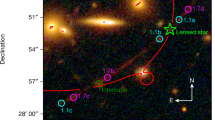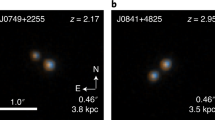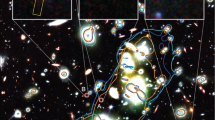Abstract
The twin quasars 0957+561 A,B, separated by only 6 arc s on the sky, have been shown to have nearly identical redshifts (ze ≃ 1.41, za≃1.39) by Walsh et al.1, who suggested that they were the double image of a single object, split by the gravitational refraction of an unseen massive intervening object. Further optical spectroscopy2 has confirmed the remarkable similarities of the emission and absorption spectra of the two quasars, and strengthened the case for a gravitational lens model. Radio maps at 6 cm made with the Cambridge 5-km telescope3 and with the VLA4 showed that, in addition to two unresolved sources coincident with the optical quasars, there were extended regions of radio emission, apparently associated with the north (A) quasar which greatly complicated the gravitational lens hypothesis. We now report a full 12-h synthesis made at the VLA at 6-cm wavelength5 which confirmed the earlier maps and showed additional features at lower flux levels. In particular, this map revealed two small radio ‘jets’, one close to each of the quasars. The absence of corresponding second images of either of these jets near the other quasar was used to rule out models in which the gravitator was located near the midpoint of the line between A and B (ref. 5).
This is a preview of subscription content, access via your institution
Access options
Subscribe to this journal
Receive 51 print issues and online access
$199.00 per year
only $3.90 per issue
Buy this article
- Purchase on Springer Link
- Instant access to full article PDF
Prices may be subject to local taxes which are calculated during checkout
Similar content being viewed by others
References
Walsh, D., Carswell, R. F. & Weymann, R. J. Nature 279, 381–384 (1979).
Weymann, R. J. et al. Astrophys. J. Lett. 233, L43–L46 (1979).
Pooley, G. G. et al. Nature 280, 461–464 (1979).
Roberts, D. H., Greenfield, P. E. & Burke, B. F. Science 205, 894–896 (1979).
Greenfield, P. E., Roberts, D. H. & Burke, B. F. Science 208, 495–497 (1980).
Gunn, J. E. et al. IAU Circ. No. 3431 (1979).
Young, P. J. et al. Astrophys. J. (in the press).
Clark, B. G. Astr. Astrophys. (in the press).
Stockton, A. (submitted).
Hine, R. G. & Longair, M. S. Mon. Not. R. astr. Soc. 188, 111–130 (1979).
Porcas, R. W. et al. Nature 282, 385–389 (1979).
Haschick, A. D. et al. (submitted).
Author information
Authors and Affiliations
Rights and permissions
About this article
Cite this article
Greenfield, P., Burke, B. & Roberts, D. The double quasar 0957+561 as a gravitational lens: further VLA observations. Nature 286, 865–866 (1980). https://doi.org/10.1038/286865b0
Received:
Accepted:
Issue Date:
DOI: https://doi.org/10.1038/286865b0
This article is cited by
-
Motion of quasar images by gravitational lens galaxies
Astrophysics and Space Science (1986)
-
IUE observations of variability and differences in the UV spectra of double quasar 0957 + 561 A, B
Nature (1982)
-
VLBI structures of the images of the double QSO 0957 + 561
Nature (1981)
-
MTRLI observations of the double QSO at 408 MHz
Nature (1980)
Comments
By submitting a comment you agree to abide by our Terms and Community Guidelines. If you find something abusive or that does not comply with our terms or guidelines please flag it as inappropriate.



